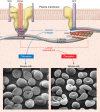Anemia lurking in introns
- PMID: 31162137
- PMCID: PMC6597212
- DOI: 10.1172/JCI129443
Anemia lurking in introns
Abstract
Anemia is defined by low levels of circulating hemoglobin, resulting in insufficient tissue oxygenation. This condition results from both genetic and nutritional factors and affects more than a billion people worldwide. For the inherited anemias, progress made over the last 40 years has increased our understanding of the structural basis for normal red cell membrane function and allowed definition of the genetic and pathophysiological bases of many human RBC membrane disorders. Despite these advances, there are continued uncertainties in the genotype-phenotype relationship in cases of severe, membrane-linked anemia. In this issue of the JCI, Gallagher and colleagues have identified a severe form of inherited anemia that results from aberrant splicing of α-spectrin, which in turn leads to abnormal erythrocyte membrane structure and function. The identification and characterization of this splicing-associated genetic disease will facilitate diagnosis and treatment of severe anemia in affected patients. These findings not only improve understanding of red cell disorders, they are likely to impact many disciplines, as the disease-associated alternate branch point utilization defined in the report may be the underlying etiology for many other inherited or acquired disorders.
Conflict of interest statement
Figures

Comment on
-
Aberrant splicing contributes to severe α-spectrin-linked congenital hemolytic anemia.J Clin Invest. 2019 Apr 30;129(7):2878-2887. doi: 10.1172/JCI127195. J Clin Invest. 2019. PMID: 31038472 Free PMC article.

